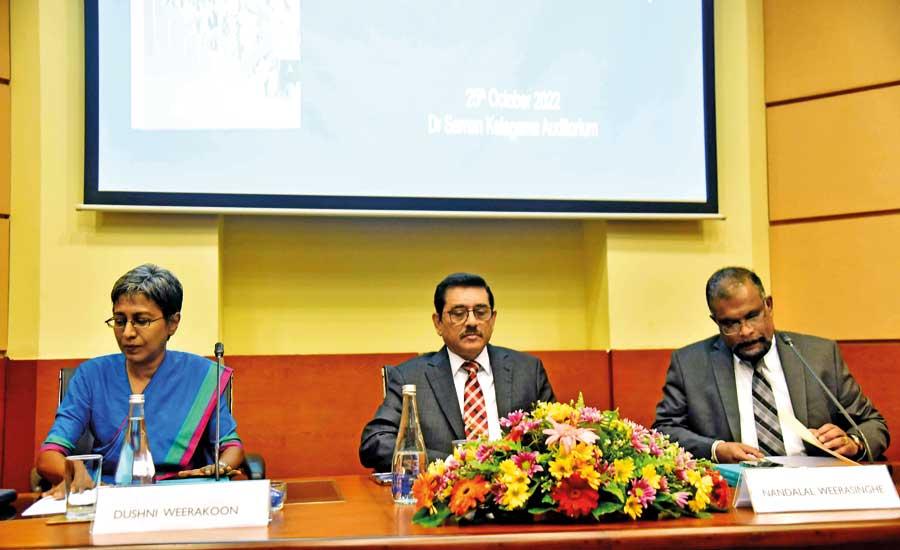Reply To:
Name - Reply Comment

From left: IPS Executive Director Dr. Dushni Weerakoon, Central Bank Governor Dr. Nandalal Weerasinghe and Treasury Secretary Mahinda Siriwardana at State of the Economy 2022 report launch
Pic by Kithsiri De Mel
By Shabiya Ali Ahlam
Crisis-hit Sri Lanka is expected to fall back in economic development while the other nations get ahead, the Institute of Policy Studies (IPS) said in its latest State of the Economy 2022 report.
The flagship report that was launched this week shed light on the fact that Sri Lanka will spend much of the immediate and near future braving through the challenges, whereas its peers are expected to emerge from the current global challenges and record economic growth.
“Economic development will be set back by years. As Sri Lanka’s real per capita GDP declines, other countries will overtake it,” said IPS Executive Director Dr. Dushni Weerakoon in her address that marked the launch of the 2022 edition of the State of the Economy report on Tuesday.
According to the comprehensive analysis carried out, the report concludes that even in the best-case scenario, Sri Lanka will see its GDP per capita contract for at least two years, before the people of the country are to witness any ease from the pain and hardship they are undergoing.
In the worst-case scenario, the country will see its per capita in the negative growth track for at least five long years.
While the policymakers and economists are hopeful that the GDP contraction will end by 2024-2025, putting Sri Lanka in the worst-case scenario is the delays and uncertainties in the debt restructuring talks and their successful conclusion.
Failing to secure a firmed up stance with the country’s creditors could drag the crisis, as the already promised International Monetary Fund bailout package is contingent on Sri Lanka securing financing assurances from its official and private creditors to restore debt sustainability.
As Sri Lanka took a decision to default its payment to creditors for the first time in April this year, the senior economist stressed efforts must be taken to make sure the country doesn’t get into serial default. Such a move would not augur well for the country, Dr. Weerakoon highlighted.
Further, given the predicament Sri Lanka is currently in, it is critical for the island nation to try and minimise output losses in the short term. This means Sri Lanka must step up efforts in concluding debt restructuring negotiations as swiftly as possible, the senior economist said.
Dr. Weerakoon also highlighted the need for Sri Lanka to establish credibility by stabilising macroeconomic fundamentals. The island nation needs to send out a message to the creditors and investors that there is recognition of things to be done and what is expected of the government is being done, she said.
In the medium term, the country requires more macroeconomic flexibility without throwing stabilisation efforts into reverse, she added.
“Over-contraction for an extended period of time will make recovery that much harder. So, we need to gradually shift to an emphasis on growth, aligned to an appropriate long-term policy framework,” said Dr. Weerakoon.